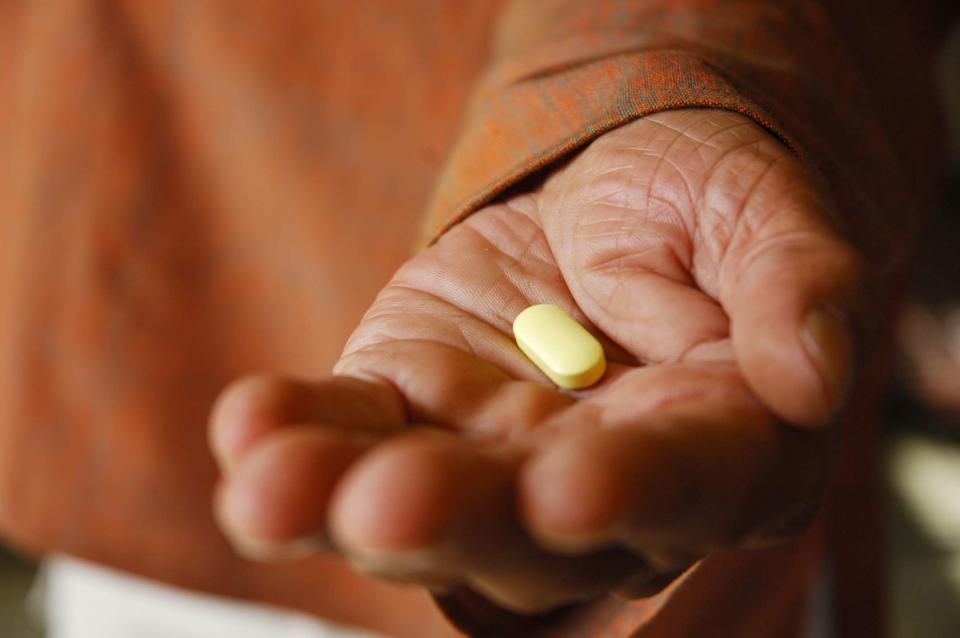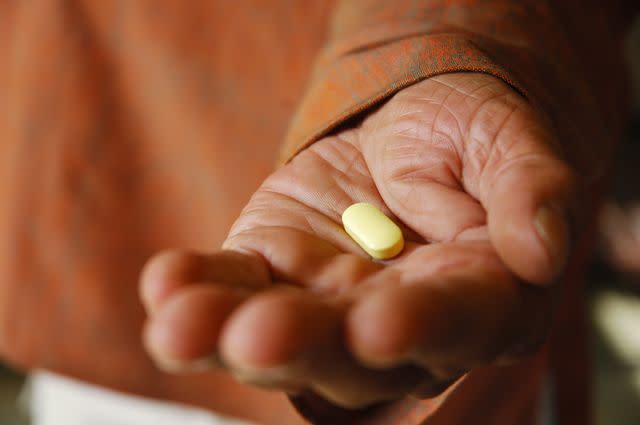Parkinson’s Disease Treatment
Drugs, Surgery, and Everything in Between

Visage / Getty Images
Medically reviewed by Huma Sheikh, MD
The treatment of Parkinson's disease (PD) focuses on improving symptoms and quality of life. Medication is the hallmark therapy, especially a drug called levodopa, which raises dopamine (a brain chemical) levels in the brain and is the best drug for controlling PD symptoms.
Other medications, like dopamine agonists or amantadine, may also reduce symptoms. Surgery, like deep brain stimulation, is generally reserved for those who have exhausted their medication options.
This article will review the medical and surgical treatments for Parkinson's disease. It will also explore the role of supportive therapies like exercise and nutrition and where you might find Parkinson's care and resources.

Visage / Getty Images
Goal of Parkinson’s Treatment
The primary goal of Parkinson's treatments is reducing symptoms to improve daily functioning and quality of life.
Parkinson's disease results from the death of dopamine-producing nerve cells in the brain. Since dopamine regulates movement, depletion produces motor (movement-related) symptoms like shaking, stiffness, loss of balance, and slow movements (bradykinesia).
PD symptoms are usually mild early in the disease course before slowly worsening, often becoming unpredictable and challenging to control.
Parkinson's Disease Is Incurable
Parkinson's disease cannot be reversed. Also, there are no medical therapies that can slow or stop the disease from progressing. That said, the numerous treatment options available can ease symptoms, providing comfort to live well again.
Medication for Parkinson’s
There are several medication options for treating Parkinson's. The medicine a person begins early on in the disease, and its effectiveness and tolerability, have an impact on future medication or surgical options. As such, it's essential to work closely with a healthcare provider who has experience treating Parkinson's disease.
Dopaminergic Medications
Dopaminergic (relating to dopamine) therapy lies at the crux of PD treatment. Dopaminergic medications fall into four main categories, listed in declining order of dopamine potency.
Levodopa
Levodopa, or L-dopa, is the most effective drug for minimizing PD symptoms and is the initial medication in the majority of people with PD.
Levodopa works by increasing brain levels of dopamine and is usually taken as the tablet Sinemet (carbidopa-levodopa).
Carbidopa blocks the conversion of dopamine outside of the brain, minimizing side effects and allowing for a smaller amount of levodopa to be taken to achieve the desired treatment effect.
Related: When to Start Levodopa in Parkinson's Disease
Two possible exceptions to starting PD treatment with levodopa include:
Levodopa requires frequent daily dosing, so people with mild PD may prefer a once-a-day drug, like a monoamine oxidase type B (MAO B) inhibitor (see below).
Levodopa is associated with the highest risk of dyskinesia, so people with PD under 50 years may opt to start treatment with a dopamine agonist (see below).
What Is Dyskinesia?
Dyskinesia is abnormal muscle movements like rapid jerking that are out of a person's control. Approximately 80% of people being treated for PD develop levodopa-induced dyskinesia in the advanced stages of the disease.
Dopamine Agonists
Dopamine agonists are medications that stimulate dopamine receptors (docking sites) in the brain. They can be taken alone or in combination with levodopa.
In addition to being a little less effective at controlling PD symptoms compared to levodopa, dopamine agonists are associated with more side effects, especially drowsiness, leg swelling, visual hallucinations, and impulse control disorders (e.g., uncontrolled and excessive gambling or shopping).
Dopamine agonists include:
Mirapex (pramipexole) is a pill taken once daily (extended-release) or multiple times daily (immediate-release).
Requip (ropinirole) is a pill taken once daily (extended-release) or multiple times daily (immediate-release).
Neupro (rotigotine) is a patch applied to the skin once a day.
Apokyn (apomorphine) is a shot given underneath the skin as needed.
MAO-B Inhibitors
MAO-B inhibitors block or decrease monoamine oxidase B. This enzyme breaks down dopamine in the brain. It can be taken alone or in combination with levodopa or other Parkinson's medications, although its effect on reducing PD symptoms is generally small.
MAO-B inhibitors include:
Azilect (rasagiline) is a pill taken once daily.
Xadago (safinamide) is a pill taken once daily.
Eldepryl (selegiline) is a pill usually taken once daily.
Learn More: The New Anti-Parkinson's Drug Safinamide
Amantadine
Amantadine is an antiviral drug believed to work by increasing dopamine's effects in the brain. It may also block glutamate docking sites in the brain. Glutamate is a brain chemical involved in altered nerve cell communication in PD.
The effect of amantadine is temporary, and the drug may be taken alone or combined with levodopa or an anticholinergic drug (see below).
Amantadine is available in three formulations:
Symmetrel is a pill taken two to three times daily.
Gocovri is an extended-release pill taken once daily.
Osmolex is an extended-release pill taken once daily.
Other PD Medications
Other Parkinson's medications that do not impact dopamine include anticholinergic drugs and catechol-O-methyl transferase (COMT) inhibitors.
Anticholinergics
Anticholinergic drugs decrease the action of acetylcholine, a brain chemical that helps regulate movement. Anticholinergics should be avoided in older individuals due to potential side effects, especially constipation, retaining urine, and thinking/memory problems.
Anticholinergic drugs used in PD include:
Cogentin (benztropine) is a pill taken twice daily.
Artane (trihexyphenidyl) is a pill taken two to three times daily.
Related: Anticholinergic Drugs: Benefits and Side Effects
COMT Inhibitors
A COMT inhibitor is an add-on levodopa therapy to manage “off” periods in advanced Parkinson's. It works by preventing the breakdown of dopamine.
What Are "Off Periods"?
"Off periods" are when a person's PD symptoms return. This happens randomly and unpredictably or because the levodopa wears off in the body sooner than expected.
Related: On-Off Phenomenon: When Levodopa Stops Working as Well
COMT inhibitors include:
Ongentys (opicapone) is a pill taken once daily at bedtime.
Comtan (entacapone) is taken with each dose of levodopa, up to eight times a day.
Tasmar (Tolcapone) is a pill taken three times daily.
Istradefylline
Nourianz (istradefylline) is a pill approved as an add-on treatment to levodopa in people with PD experiencing "off" periods. It's taken once per day and is believed to work by blocking adenosine receptors found on dopamine-producing nerve cells in the brain.
Related: Adenosine: A Novel Drug Target in Parkinson's Disease
Surgery for Parkinson's
Chronic drug treatment of Parkinson's can eventually lead to motor complications, namely "off" periods and levodopa-induced dyskinesia.
Surgery can help manage these motor complications in select people and improve symptoms when medications are not working well enough.
The two main types of Parkinson's surgeries include:
Device-assisted therapies
Ablative surgery
Device-Assisted Therapies
The primary device-assisted therapies are deep brain stimulation and Duopa therapy (continuous levodopa-carbidopa intestinal gel).
Deep brain stimulation (DBS) is the most common brain surgery to treat Parkinson's disease.
DBS involves a neurosurgeon first placing an electrode deep within the brain in an area that regulates movement. The electrode is then attached to a device (called an implantable pulse generator) placed underneath the skin near the collarbone.
The implantable pulse generator delivers electrical signals to the electrode in the brain via a wire under the skin. These electrical signals work in a complex (and still not fully understood manner) to decrease the motor symptoms of PD.
Related: The Anatomy of the Brain
Duopa Therapy
Duopa is a gel of levodopa and carbidopa that is continuously delivered (up to 16 hours a day) into the intestines via a percutaneous gastrojejunostomy tube (a type of feeding tube).
The feeding tube is attached to a portable battery-powered infusion pump, carried in a small bag around the neck or waist.
The intended effect of Duopa therapy is to treat the motor symptoms of Parkinson's, just like levodopa, but with improved impact due to its direct access to the intestines. The immediate delivery of the drug to the intestines also reduces "off" periods.
Ablative Surgery
Ablative surgery involves a surgeon targeting a specific brain area affected by Parkinson's using sophisticated imaging techniques. The surgeon then opens up the skull and destroys the tissue using radiofrequency in that area.
Magnetic resonance imaging (MRI)–guided focused ultrasound is a newer, less invasive method that uses high-energy ultrasound beams to destroy brain tissue. This method avoids undergoing a surgical cut in the skull to access the targeted area.
Related: Brain Surgery for Parkinson's Disease: Overview
Supportive Parkinson’s Treatments for Symptom Management
Beyond medical therapies for treating Parkinson's disease, healthy lifestyle habits, such as exercise and "brain-healthy" eating patterns, may help people better control their symptoms and enhance their overall quality of life.
Even more, scientific evidence suggests that diet and exercise could help slow the disease down. If you have Parkinson's disease, talk with your PD care team about seeing a nutritionist and physical therapist to help guide you.
A nutritionist may recommend the Mediterranean diet, which is rich in fresh fruits and vegetables, olive oil, fish, nuts, and seeds. These foods have antioxidant and anti-inflammatory properties, which help nourish the brain.
Likewise, a physical therapist can help you devise an exercise program that fits your unique goals and needs. Several forms of exercise, including running, dancing, tai chi, and yoga, have been found to improve various PD symptoms, including walking and balance problems.
Related: Home Exercises for Parkinson’s Disease
Where to Get Parkinson’s Treatment
Managing Parkinson's disease is a lifelong journey that requires a well-thought-out treatment plan and close follow-up with a PD care team.
If you have PD, seek care from a neurologist (a doctor specializing in nervous system conditions) with experience treating Parkinson's disease, often called a Parkinson's specialist or a movement disorder specialist.
One potential resource for finding a Parkinson's specialist is the Global Care Network, offered by the Parkinson's Foundation. This network provides information about Parkinson's treatment centers across the United States and a few other countries.
Besides seeing a Parkinson's specialist, it's sensible to learn as much as possible about the disease and utilize resources that may benefit your health and well-being.
As an example, the American Parkinson Disease Association (ADPA) is a large organization devoted to helping individuals with PD live life to the fullest.
The ADPA offers numerous free services, including educational webinars, support groups, and online classes like virtual tai chi, yoga, and seated exercises. They also provide information about PD-related clinical trials.
Related: What Is Parkinson’s Disease?
Summary
The goal of Parkinson's treatments is to reduce symptoms such as stiffness, uncontrollable shaking, and slow movements. Medication is the mainstay treatment, especially levodopa, a drug that increases dopamine levels in the brain. Drugs like dopamine agonists, amantadine, or anticholinergics may also be prescribed.
Surgery for Parkinson's is sometimes considered when medications stop working well. Exercise and nutrition are also essential components of a Parkinson's care plan. These supportive therapies can improve symptoms and quality of life and may help slow the disease down.

